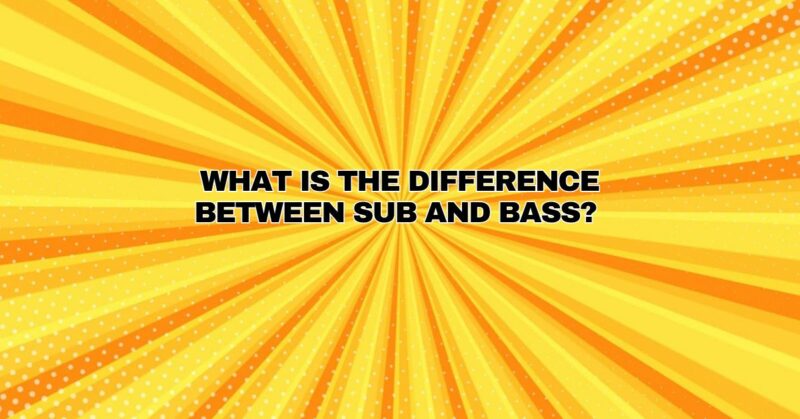In the intricate world of sound and music, the terms “sub” and “bass” often resonate, sometimes interchangeably, as they both dive deep into the lower frequencies of the auditory spectrum. However, these terms signify different dimensions of low-frequency sound that contribute to the sonic tapestry in unique ways. In this comprehensive article, we will explore the distinctions between “sub” and “bass,” shedding light on their roles, characteristics, and how they shape our auditory experiences.
Understanding Sub and Bass Frequencies
To comprehend the difference between “sub” and “bass,” it’s essential to first grasp their respective places within the frequency spectrum.
- Sub Frequencies: “Sub” is a shortened form of “sub-bass,” referring to the deepest and lowest frequencies in the audible spectrum. Sub frequencies typically extend from around 20 Hz to 60 Hz and are characterized by their powerful, visceral impact. These frequencies are often felt more than they are heard and are responsible for generating sensations like vibrations in your chest during a loud concert or the rumbling of an approaching thunderstorm.
- Bass Frequencies: On the other hand, “bass” encompasses a broader range of frequencies, typically spanning from about 60 Hz to 250 Hz. Bass frequencies provide the foundation and rhythmic groove in music, including the thump of a kick drum, the resonance of a bass guitar, and the warmth in the lower registers of other instruments. Unlike sub frequencies, bass frequencies are more audible and contribute significantly to the overall musical experience.
Key Differences Between Sub and Bass
- Frequency Range:
- Sub Frequencies: Sub frequencies dwell in the lowest realm of the audible spectrum, primarily below 60 Hz. They produce ultra-deep vibrations and are often associated with intense physical sensations.
- Bass Frequencies: Bass frequencies occupy a higher segment of the frequency spectrum, ranging from approximately 60 Hz to 250 Hz. They contribute to the rhythm, groove, and tonal richness of music.
- Audibility and Perception:
- Sub Frequencies: Sub frequencies are often felt more than they are heard. They create a tactile, immersive experience, such as the bone-rattling bass at a concert or the deep rumble of an explosion in a movie.
- Bass Frequencies: Bass frequencies are more audible and contribute to the tonal character and rhythm of music. They are responsible for the punch of a kick drum, the resonance of a bass guitar, and the depth of male vocalists.
- Musical Applications:
- Sub Frequencies: Sub frequencies find their primary application in genres like electronic dance music (EDM), hip-hop, and cinematic soundscapes. Subwoofers are commonly used to reproduce sub frequencies, enhancing the immersive experience.
- Bass Frequencies: Bass frequencies are versatile and essential in a wide range of musical genres, including rock, pop, jazz, and classical music. They provide the foundational groove and rhythm in music.
- Sound System Requirements:
- Sub Frequencies: Reproducing sub frequencies demands specialized equipment, such as subwoofers with large drivers and dedicated amplification. Proper room acoustics are also critical for subwoofer performance.
- Bass Frequencies: While bass frequencies can be handled by standard speakers, dedicated bass amplification and speakers can enhance the clarity and impact of bass instruments.
Conclusion
In the realm of sound and music, “sub” and “bass” represent distinct facets of the low-frequency spectrum, each with its unique role and characteristics. Sub frequencies dive to the deepest depths, creating visceral sensations, while bass frequencies provide the rhythmic foundation and tonal richness that define the music we love. Understanding the difference between these two dimensions of sound enriches our appreciation of music and audio experiences, whether we’re feeling the sub-bass thump at a concert or grooving to the bassline of our favorite song.


